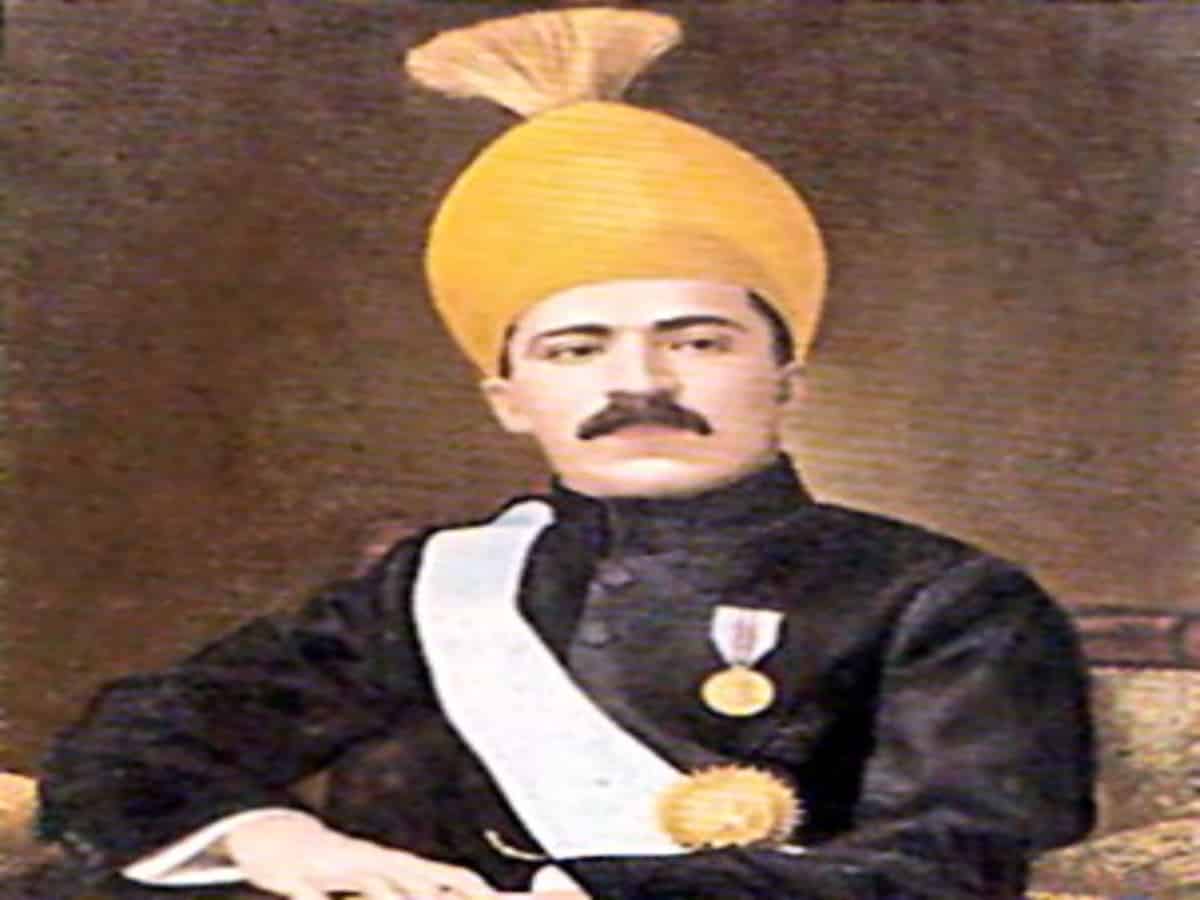
Hyderabad used to be a large princely state, the size of Kansas, in the middle of the Deccan Plateau in Southern India. It merged with free India more than a year after the latter gained independence, and only after protracted negotiations, over which the ruling prince, the Nizam, apparently lost control to fundamentalist Muslim elements that had begun to dominate political life in the state. In September 1948, its patience at an end, the new Indian government launched a military invasion of Hyderabad, forcibly integrating the state into the Indian Union. But the Nizam was treated well, and his great wealth and private estates were left intact.
Hyderabad had been ruled by an unbroken line of hereditary Nizams, stretching back to their common ancestor, Asif Jah, Nizam Ul Mulk, a distinguished governor (or Nizam) under the last Mughal emperors of India. The Muslim dynasty that he established in 1724 represented a kind of impressive appendix to the vanished Mughal Empire. Under the British, who moved into India as the Moguls declined, the Nizams ruled their large kingdom with a wide though contested margin of internal autonomy.
Last in line was His Exalted Highness Mir Osman Ali Khan, Nizam the Seventh, who reigned from 1911 to 1948. In the early years of his rule, he was known for his progressive ideas. He promoted education, abolished capital punishment, constructed an impressive university, beautified the city of Hyderabad, and developed a strong civil service, based on merit. The Nizam liked to surround himself with able ministers, and attracted many talented professionals from other parts of India. He was secular in outlook, and had a developed literary taste in Persian and Urdu. For those who knew him, he was an active and forceful ruler. Inevitably, he clashed with the British, most famously with Lord Reading, Viceroy of India, in 1926, on the issue of British paramountcy over Hyderabad. After the clash, his contacts with Delhi became rather tenuous, and his reclusive tendencies came to the fore.
There was in fact another side to the Nizam. Despite a progressive outlook, he displayed certain personal tendencies that exposed him to criticism. He maintained a harem; he took opium; he did little to prepare his Muslim subjects for the eventual merger of his kingdom with free India. But he could also be far-sighted. As Indian independence approached, he made a thorough study of his constitutional position with the help of Sir Walter Monckton, the leading constitutional lawyer of his time, so it cannot be said that he was caught unawares by the departure of the British. He had an avaricious streak but was capable of making the generous gesture. He was fabulously rich, one of the wealthiest in the world, but lived quite modestly, and often dressed carelessly, even shabbily. Whatever the reasons, the Nizam we read about in contemporary accounts is a one-sided caricature portraying a miserly, reclusive eccentric, an autocratic ruler, out of touch with his times. This is not quite accurate, but what is indisputable is that he was careless of his public image, and earned a bad press as a consequence.
History has been unkind to the Seventh Nizam. He was, in his time, the leading Muslim prince in India, undeniably a force to reckon with. His imprint remains discernable on some of the most significant events of the day, from his contacts with the Ottoman ruling family to his dealings with the leading national figures in both India and Pakistan. He could be calculating and strategic. He played for big stakes, and time and again opened up possibilities that could have led to grand outcomes. It is worth considering in this light his cultivation of the family of Abdul Mejid the Second, over a period spanning decades. It is an account worth exploring, as an interesting historical cul-de-sac in 20th Century Muslim history.
For Muslims throughout the world, the abolition of the Caliphate, soon after the collapse of the Ottoman Empire at the end of the First World War, was a highly symbolic event. Abdul Mejid the Second, son of a previous Emperor, Sultan Abdulaziz, and Crown Prince under the last of the Ottoman Emperors, Mehmed VI, never ascended the Ottoman throne, as Turkey was by then a republic under Ataturk. But in November 1922, he was declared Caliph, a title that puts the bearer at the pinnacle of Muslim society, as its pre-eminent secular and spiritual voice, the bearer of the grandest titles in the Muslim world, including “Successor to the Prophet”, and “The Shadow of God on Earth”. Of course, Ottoman fortunes had been in decline for some time, and there was a certain inevitability in the last Caliph’s departure into exile in 1924, when Ataturk abolished the Caliphate. But powerful emotions were aroused by his fall and Muslims as far away as India and Sudan rose up in revolt. Their British rulers were hard put to control the Khilafat Movement, as it came to be known in India, until it gradually subsided.
The Nizam reacted to these events with an act of personal generosity, by providing regular financial support to the fallen Caliph, in exile in France. And he did not leave it at that. Some years later, he sent a proposal of marriage, on behalf of his two eldest sons, asking for the hand of the Caliph’s daughter and niece. The Caliph had previously declined offers of marriage to his daughter from the Shah of Iran and King Fouad of Egypt on behalf of their respective sons and future monarchs, Mohammad Reza and Farouk. Such was the Nizam’s standing in the Muslim world that alliance with his family was preferred over these distinguished royals. Of course, the Caliph was deeply in the Nizam’s debt for the latter’s generous support in his exile; perhaps that too tilted the balance in his favo
The weddings took place in 1931, in Nice, France. They were presided over by Abdul Mejid himself. Contemporary pictures show two very striking young Turkish ladies, the tall and elegant Princess Durruhsehvar and the beautiful Princess Niloufer, being wed to the stocky young princes of Hyderabad. Matchmaking was something of a hobby of the Nizams, as it is of all royals. This time he had excelled himself, forging an alliance with the Ottoman Imperial House.
In due course, the eldest prince, the heir presumptive, Azam Jah, produced two sons, Mukarram Jah, Mir Barakat Ali Khan (born 1933) and Mufakkam Jah (born 1935). In 1948 they were sent to Harrow, the famous English public school. Presumably their mother, the Turkish Princess Durreshavar, wanted to take them away from Hyderabad as that state plunged into a frenzied and ultimately futile resistance to merger with the newly-independent Indian Union.
Harrow was followed by Sandhurst and Cambridge University. Then, their education complete, the princes returned home in the early 1960s. They were young men now. The elder of the two, Mukarram Jah, the first grandson of the Nizam, was by all accounts a most engaging man, tall, good-looking and well spoken. He was an instant hit in Hyderabad and beyond. The Indian Prime Minister, Nehru, himself a Harrovian, was greatly taken with the Prince. This was of course independent India, a republic. On the face of it there was no room for royalty. But Nehru was always on the lookout for acceptable leadership for the large Muslim minority in India. The young prince was very suitable material. He worked for some time in Delhi, close to Nehru, in his Private Office, and later in the Ministry of Foreign Affairs. Then, within a few years of his return, before he turned thirty, the Prince was appointed Pro-Vice Chancellor of the University of Hyderabad, and sundry other honors and offices seemed within his grasp.
A great future was anticipated for the Prince. The vice chancellorship would be followed by other high offices, perhaps an ambassadorship or two, and in due course, a governorship. His grandfather, the Seventh Nizam, had been appointed Governor of Hyderabad in 1950, two years after giving up his rulership. He had remained Governor until his retirement in 1956. There was nothing to stop the government and Nehru from bestowing similar favors on the young man. And there seemed to be no limit to how far he could go. Perhaps one day he could aspire to the highest office in India. The convention was developing at that time of having one of the positions, either the presidency or the vice presidency, occupied by a worthy Muslim. So, it seemed that dedicated service in a succession of high offices could lead all the way to the Presidency of India. And these were not pipe dreams. Or if they were, the government authorities seemed determined to nurture them.
It became known that Nizam intended to recognize the grandson as his direct heir, bypassing his son, who was in declining health. The government seemed to welcome the idea. In 1959, the Prince married into a Turkish family, like his father. But unlike his father, he seemed to lead a sober life of quiet domesticity and assiduous public service. When Nizam died in February 1967, the Government of India immediately moved to declare the young prince his grandfather’s successor, and formally recognized and validated his hereditary titles. Henceforth Prince Mukarram Jah was to be known as His Exalted Highness, Mir Barakat Ali Khan, Mukarram Jah, Nizam the Eighth.
Later that year, in October 1967, the new Nizam celebrated his 34th birthday. It was a glittering occasion, arranged at the Chowmahalla Palace, one of the many residences and palaces of the Nizams. Hyderabad has a deserved reputation for the splendor of its social events, marked by elaborate formality and sumptuous food. The party took its stately course, and eventually came to an end and the assemblage prepared to leave. The Prince, the new Nizam, was due to leave first, according to protocol. Imagine the scene: the Prince descending the stairs into the driveway, as his limousine sweeps up, watched by the worshipful gathering. It was at this moment that something very ordinary happened but was taken to be an occurrence of dire portent.
As the Prince’s car swept up, its engine sputtered and died. Before anyone could stop him, the new Nizam stepped down to the limousine, unlatched its bonnet, and disappeared under it. The assembled gathering was dumbfounded. This was a mechanic’s job; what was the Prince doing under the hood? It was recalled then that the Prince had a fascination for everything mechanical, vehicles of all kind: cars, tanks and farm machinery in particular. Between Harrow and Sandhurst, it was said that he had been attracted to an apprenticeship at Rolls Royce. In a single, unpremeditated action, the Prince had stepped out of his assigned role, transforming his public image.
It took a few years for what the car incident had foreshadowed to actually came about. A wonderful future of leadership before him, the prince showed diminishing interest in a life of public service. Those with long memories recalled the wily old Nizam, who had lost his kingdom but had placed unimaginable possibilities within the grandson’s reach. All the elements were there: the great wealth, support in the topmost circles of government, the path apparently leading to the highest political offices in India. There was perhaps the possibility, one day, of claiming the Caliphate, once he had achieved high office. And the timing seemed just right for the emergence of a Muslim leader some time in the closing decades of the twentieth century.
It was not to be. The fabulous inheritance attracted numerous claims, from family and retainers, and the Prince was besieged with hundreds of court cases. The Government of India could have provided immunity from legal process, but did not appear so inclined probably because the political climate had changed.
The 1967 national elections witnessed a mass departure of former rulers from the ruling Congress Party to the Swatantra Party. In June the same year the Congress Party passed a resolution to abolish their privy purses. The Constitution (24th Amendment) Bill 1970 passed the lower house, the Lok Sabha, but was defeated in the Rajya Sabha, the upper house of parliament. The constitution was finally amended after the Congress Party, led by Mrs. Gandhi, scored a landslide victory in 1971. Privy Purses were abolished and all rights and privileges of the former rulers extinguished. Clearly, the authorities were no longer interested in nurturing the new Nizam’s prospects. That combined with the claims in court probably eroded any remaining enthusiasm the Prince might have retained for a public role. In 1973 he moved to Australia, having acquired a large sheep station there. At that juncture his marriage with Princess Esra fell apart. In the following years he married several times, it is reported; later there was a reconciliation with Princess Esra. He lived in Australia for twenty-three years. There His Exalted Highness Prince Mukarram Jah, Nizam the Eighth of Hyderabad, the direct descendant of the Caliphs of all the Muslims, came to be known with that cheerful Aussie familiarity as Hyderabad Jack. In 1996 he moved to Turkey where he lived quietly and modestly to the end of his days.

Masood Hyder grew up in Hyderabad. He is a graduate of The London School of Economics and worked at the UN for 20-plus years. Later he taught at Syracuse University, as Professor of Practice. He retired in 2021 and lives in Connecticut, USA.

